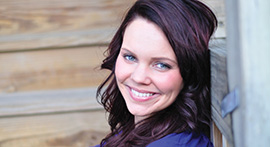
Stacy Nadeau (right), one of the six original models in Dove’s Campaign for Real Beauty, visited campus to discuss body image, using photos like this one and survey results from the campaign.
Stacy Nadeau, a model for the , is on a mission to help change people’s perceptions. “I want to challenge you to find your own best, healthy self, where mental health and physical health meet in the middle,” she told the audience in Golden Auditorium on March 6.
Nadeau spoke about the ever-growing global issue of body image and how it is affected by the media.
Using statistics and images, Nadeau showed how some media campaigns have led to an all-time high in eating disorders, depression, and other unhealthy habits fueled by the obsession to achieve an unattainable image of beauty.
Global survey results prompted Dove to challenge stereotypical definitions of beauty. One statistic, for example, showed that only 2 percent of women around the world considered themselves beautiful. Dove’s campaign, therefore, focuses on displaying images of real, relatable women from diverse backgrounds.
Dove’s “radical” idea of not airbrushing or Photoshopping images has sparked reactions, forced people to think, and started something of a revolution.
One of the original six women to participate in the campaign, Nadeau has been spreading the word for almost 10 years.
 She explained how images of an everyday girl like herself became plastered nationwide, in magazines, on billboards, and even bus stops — in her underwear — and how she became invested in sharing Dove’s message.
She explained how images of an everyday girl like herself became plastered nationwide, in magazines, on billboards, and even bus stops — in her underwear — and how she became invested in sharing Dove’s message.
Nadeau and the other models have promoted the campaign through talk show appearances, other interviews, and greeting people on the street with Dove products.
The response — both positive and negative — from the public and the media has proven that people are talking about the issue.
Now Nadeau is calling on everyone — women and men — to keep talking, speak up, and discuss ways to incite more action.
“Taking little steps is key,” she said. “Be a friend, to others and yourself. Stop creating negative checklists about your body. Stop bonding over conversations about things we don’t like about our bodies. Let’s change the conversation!”
One way that ĐÂ°Ä˛ĘżŞ˝±˝áąű has stepped up to this challenge is through Project Beauty, a group spearheaded by Emily Sisto ’16 and Alyssa Berger ’16. They were inspired by personal experiences, as well as the struggles they’ve witnessed among other young women.
“We wanted to shed light on the topic,” said Berger, vice president of Project Beauty.
“We want to be a support group on campus and let people know that beauty isn’t homogeneous,” added Sisto, group president. “There are many different forms and shapes — not just one, correct image.”
In addition to bringing Nadeau to campus, the group has posted positive body image messages — “Beauty is more than just a number on the scale” and “You only have one body, take care of it” — around the gym and in campus bathrooms.
The counseling center is also involved with sharing Project Beauty’s message and offering its services in relation to body image issues. Project Beauty also plans to collaborate with the Active Minds student group, which focuses on mental health awareness, as well as the Shaw Wellness Institute.
As the group plans more activities, they’re brainstorming ways to bring more awareness to male students, because this is a topic relevant to everyone.
“More guys are slowly but surely starting to introduce themselves to the club,” said Berger. “There were a couple of men at the Stacy Nadeau talk; so, it’s a start!”
